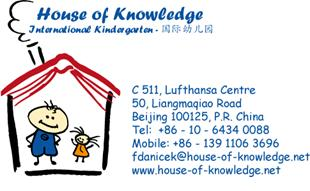In China bilingual kindergartens are becoming more and more popular, where children as young as one and a half are being taught in English and Chinese. International House of Knowledge (HoK), a kindergarten in Beijing, has taken this one step further and offers three languages; German, English, and Chinese. The kindergarten is split into three different age groups; Nursery (20 months- three years), Middle Age (three to five years), and Pre-School (four to six years). Each age group receives a different proportion of each main language.
The Nursery Group is lead by a native German speaker, with two Chinese assistants and one German assistant. The group also has activities lead in English twice a week. The Middle Age group is also lead by a native German speaker, and assisted by two Chinese teachers. Their classes are in German and Chinese in the morning and English in the afternoon. The Preschool group is lead by a native English speaker, and has one German assistant. Here the majority of the lessons are in English, with Chinese once a week, and German activities in the afternoon. “We are the only kindergarten that enables children to be immersed in three languages” said Farshad Danicek, Hok Principal.
So how does this work? HoK believes that early childhood education is an active and social process where learning is experienced through the senses and fun. When Nursery children first arrive at the kindergarten, the most important thing is to develop a strong bond with the teachers, to feel comfortable in the classroom, and then to start working with the teachers on small ‘projects’. These projects will continue all the way up to Preschool.
A project can be an idea or theme thought up by the teachers, or a question or idea proposed by the children. The children are encouraged to ‘learn to learn’; to search and investigate independently to discover their own answers and information. For each project, all the teachers at HoK must work together to create common aims, vocabulary, games, and art and craft activities that fit the project.
Even though many of the teachers at HoK are bilingual themselves, some even trilingual, it is important that they only speak to the children in their native language. This helps to prevent the children from making the same mistakes as non-native speakers might make. However, it is essential for the teachers to work as a team to be able to communicate properly with each other, so outside of the classes all three languages can be heard and spoken!
Jennifer, the Chinese Teacher for the Middle-Age group at HoK is working on her latest project: Healthy Food. To introduce the students to the topic she brings in a selection of food; fruit, vegetables, chocolate, chips, etc. In the classroom she will let the children examine the food and discuss each one- What is it called? Do they like it? Is it healthy? She might even let them taste the food.
Jennifer has activities similar to this planned out for as long as the project requires (typically anywhere from 2-4 weeks). She also gives a copy of her project plan to the other teachers. This means that during the Middle Age group’s English or German class, they will continue with the Food project in the other two languages.
“It is not important for every child to understand every word of every class, but it is necessary for the children to understand the context” explains Farshad. “If a child can grab one word out of a sentence, it will bring the child closer to the language.” For example, if a child is a native German speaker, he will fully understand the lesson taught in German. This gives him a basic idea of the food project. Now, when he has a similar lesson in Chinese, he may not able to fully understand everything being said, but he will pick up some vocabulary words and will become more familiar with the Chinese Language and learn more about the project being taught.
“People often think that it is not necessary to introduce a second language until a child is 7 or 8 years old. However, it is shown that at ages six and under the children are more sensitive, and are able to absorb languages better. It is possible for two or more languages to be learnt simultaneously if the child interacts with native speakers of both languages.” explains Farshad. “It is actually possible to have more than three languages. If a child is with HoK from Nursery until preschool, they will start school with a large base in German, English, and Chinese, which will include reading and writing skills in one of those languages. Once the child reaches fourth grade, they will be able to start learning even a fourth language!”
Farshad stresses that it is important not to worry about small grammar mistakes that the children might make. As long as the language immersion is correctly carried out at a school; where teachers are native speakers who are talking only in their native language, mistakes will not be a problem. “The earlier a child learns a language, the easier it is for them to learn”
Already HoK has seen its methods succeeding. Children with only Chinese spoken at home are now able to converse freely in any of the three languages. Preschool children who arrived only speaking German are now able to hold a conversation in English, and know some basic Chinese vocabulary. It is amazing to see how quickly the children can pick up new languages.
Additional information about the “House of Knowledge” please find here.


Die Datenschutzbestimmungen habe ich zur Kenntnis genommen.